[Updated June 22, 2018]
CRATE TRAINING BENEFITS OVERVIEW
1. When doing early crate-training, don’t let your dog out of the crate when he’s whining or barking. Even if you’re certain he really needs to go potty, try to wait for a few moments of silence before opening the door.
2. Use the crate as a rewarding place, not a punishing one! If you use it consistently for “time-outs” rather than “time in with a Kong,” your dog will start to resent and avoid it.
I am a huge fan of crate training for dogs. I think the ability to spend an extended amount of time in an enclosed space quietly and calmly is a valuable life skill for dogs. And it certainly has dozens of benefits for us, too.
© Dahlskoge | Dreamstime
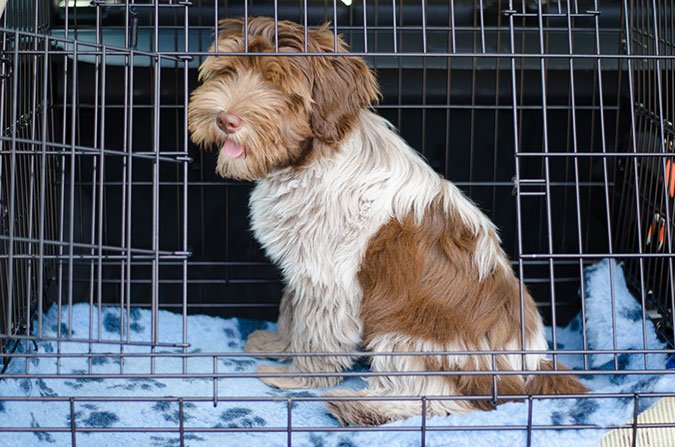
Benefits of Crate Training for Your Dog:
1. Dog has safe space where he can’t be bothered by other dogs or household pets or people.
2. Dog has a safe place to enjoy a bone or food-stuffed Kong, without worrying about having it taken away from him.
3. Dog has a comfortable, enclosed place to nap or sleep – somehow reminiscent of the canine’s evolutionary den.
4. In an emergency or in the case of an injury that requires the dog to be kept quiet, the dog can be safely contained, keeping him out of harm’s way in a familiar, comforting environment. This point is really important to me. In California, I’ve lived in areas that suffered week-long floods and fires that burned tens of thousands of acres. I was living in San Francisco when the Loma Prieta earthquake struck in 1989, sparking fires that destroyed dozens of homes. I have friends in the Bay Area who had to evacuate their neighborhood after a gas pipeline explosion a few months ago. I haven’t yet needed to evacuate my pets, but I could if I had to – and I wouldn’t have to worry that my dog was traumatized and freaking out because he was put into a crate. I also feel much better knowing that if he’s ever confined to a crate for a hospitalization or recovery from an injury, he’ll be absolutely content and comfortable.
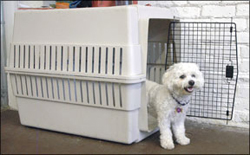
5. If the dog is boarded or has to stay overnight or for an extended stay at a veterinary hospital, he’ll be much less anxious if he’s well habituated to his crate. My friend and trainer Sarah Richardson, of The Canine Connection in Chico, California, puts it this way: “It’s like eating at McDonalds in a foreign country – a familiar place where they can relax and know what to expect.”
Richardson also operates a daycare and boarding facility. She says there is a striking difference between dogs who are crate-trained and those who are not. “Daycare and boarding can be exciting for a dog, but they can also be stressful. Crate-trained dogs always seem grateful for some rest and relaxation in the midst of a stimulating stay here, and they come out of the crate refreshed and ready to play again. The crate has become their cue for relaxation. It’s much more difficult for dogs who aren’t crate-trained to fully relax and sleep well when they are in unfamiliar surroundings.”
Benefits to an Owner of Crate Training:
1. Peace of mind in an emergency (again, fires, flood, etc.).
2. Peace of mind that a comfortably crated dog can’t destroy one’s house or car.
3. As a testament for all the reasons to train your dog to perform a rock-solid sit, trainer Ian Dunbar often cites a list of things that a dog can’t do when it is sitting, such as jumping up, humping your leg, getting in a fight, etc. The list of things a dog can’t do while crated is even longer, and includes chewing through electrical cords, stealing your socks, getting into the garbage, tormenting the cat, and peeing behind the sofa.
Also, I was caring for a friend’s dog once, and left him in my car for a short time while occupied with something else. When I came back, I found that he had chewed through every seat belt in the car. I don’t leave dogs uncrated in my car any more!
4. Crates are a valuable tool for house-training a dog. Few dogs will soil their crates if they can help it. After each stint in a crate, take them directly outdoors to potty. If they don’t go, bring them back inside and pop them right back into the crate. If they do potty, reward them lavishly, and allow them to be free in the house for a while – but only about as much time as it might take for them to need to go potty again. At that point (and it depends on their age, when and how much they eat and drink, and other factors that you will know best), take them back outdoors. If they go potty, reward them again. If they don’t, back into the crate they go.
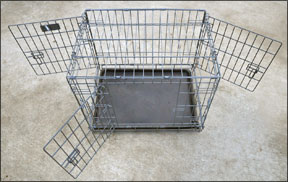
See “How to Potty Train A Dog” for more information on a potty training program for puppies, or remedial training for adults.
5. A crate and crate-trained dog ensure that you and your dog will be welcome at most friends’ and relatives’ homes. I recently stayed at a friend’s house over the holidays, with my foster dog! She doesn’t have enough training or self-control to abstain from chasing a strange cat, eating the cat’s food, chewing on the furniture, or stealing food off the table, but none of these things happened, because she was happy to spend all of her unsupervised time in their home in her crate. My friend commented, “We’re crate-training our next dog, for sure!”
6. Crates enable me (and others) to foster dogs from the shelter. I can say in all confidence that at least five dogs have found really great homes because I took the time to house and train them, and find just the right family to adopt them. If I didn’t have a safe place to put an untrained dog at night, or even just while I run to the grocery store, I wouldn’t be able to provide this service.
Prepare for Crating
You’ll need a few things to get started on the crate-training project.
First and foremost, you need the right crate. There are three major types that are appropriate for training: plastic (or aluminum) airline-style crates; wire crates (they look like cages); and “furniture” style or “fashion” crates that are disguised to blend in with your decorating motif. Most dog owners choose a utilitarian (and affordable) plastic or wire crate; the aluminum and fashion models cost upwards of $500. (There are also “soft” fabric crates; these are appropriate only for dogs whose crate-training is rock-solid, since a determined or panicked dog can very easily chew or scratch his way through the mesh and escape.)
Each of the two most popular types offer one major benefit. Plastic crates seem to evoke the “den” feeling for the dog; many dogs accept being in a solid-seeming structure more readily than being in an airy cage. Wire cages offer more flexibility in where you can put them; most have at least two doors and some have three. This helps you position the crate in just about any corner or cranny in your home. Dogs will generally accept either type of crate, if you introduce the dog to the crate properly and don’t abuse or overuse crating.
The crate you buy needs to be large enough to permit your dog to comfortably enter, stand, turn around, and sleep in his favorite position. If he can’t get comfortable, the odds of his acceptance of the crate are poor! Measure your dog’s height and length; don’t rely on your memory and estimation of his size when ordering. If you’re in doubt, get the next size up. More room is always better, with the following exception: buying a crate for your medium- to large-breed puppy.
Knowing that your pup is going to stand 26 inches or so at the shoulder, and weigh 80 or more pounds, you select a very large crate. It’s good to plan ahead, right? Yes, but in the here and now, instead of providing a snug little studio apartment, we’ve supplied that puppy with a vast loft, complete with what he may perceive as a backyard bathroom. In other words, if he has just enough space to feel comfortable, he’ll make an effort to “hold it” in order to keep his bed clean. If he has too much real estate, he’ll probably start using some of it for going potty.
Most wire crates can be ordered with a divider panel that allows you to “fence off” some of that extra space while the puppy is little, and gradually expand the room he needs. I’ve never seen a plastic airline crate that offers this feature, although I’ve known owners who actually bought a small crate for the pup, and a larger one when he was older, larger, and already reliably crate-trained.
Next, find a good place for your dog’s crate. It should situated in a place that is neither too hot (next to a heater vent or in direct sun from a window), nor too cold (on a concrete floor in a chilly room or in a breezy, unheated hall). Remember that the dog will be stuck in that one temperature zone; you are depriving him of the ability to get up and move to a more temperate location, so the spot should be pretty comfortable.
Consider, also, your dog’s temperament and the traffic flow in your home. If your dog gets overstimulated by the sight and sounds of your kids’ playing and running with their friends, put the crate somewhere out of the flow of traffic. But if your dog gets a little anxious when he’s left alone, put his crate close to the center of action in your home, so he can be reassured as much as possible by the sounds of someone cooking in the kitchen or the television.
Note that if your dog displays serious anxiety when separated from the family, and hurts himself, destroys the crate, eliminates in the crate, and/or vocalizes nonstop, you’ll need the services of an experienced animal behavior professional to help properly diagnose and treat the behavior. See “Serious Separation Anxiety Calls for a Different Approach,” below.
The next thing you need to do is make sure that the crate is an incredibly cozy and inviting space for your dog. It should be equipped with a thick, comfortable bed or pad – not a thin little towel. The only exception to this would be for dogs who chew, eat, or otherwise destroy their beds; then you might have to experiment to find something that is comfortable but resistant to chewing. My dog is attracted to chewing up foam-filled beds, so I bought two of the thick, fuzzy “EcoNap” mats (not one of the many thin imitations) from West Paw Design. Otto is comfortable and the washable beds are still intact and attractive after two whole years.
The only acceptable reason (from my view) for not providing your dog with a thick bed in his crate? Very young puppies and a few adult dogs sometimes prefer peeing on a soft surface; you might have to eliminate padding for them, which means you have to keep the crate somewhere warm (in cold weather). You also should shorten the time you leave these individuals in a crate so they don’t feel the need to eliminate in their dens.
The last things you need for successful crate-training are a good supply of safe and attractive chew items and/or food-stuffed toys, such as Kongs or one of the stuffable “Busy Buddy” toys from Premier Pet Products.
Don’t Crate Dogs With Severe Anxiety
It’s a dilemma: A dog with severe separation anxiety may destroy their homes in a desperate effort to distract and console themselves when he is in the midst of an attack of separation anxiety. He may eat couch cushions, claw his way through drywall, attempt to crash through windows, and/or urinate and defecate all over the house. Sound like a dog you’d like to put in a crate? Actually, probably not.
Some dogs actually suffer worse symptoms when they are not only left alone, but also, when locked in a crate, are deprived of the things that might make them feel a bit better, like lying on your bed or sofa, or being able to look out the living room window from time to time. Most trainers have heard at least one sad story from a desperate owner whose dog mutilated himself — with bloody paws or even broken teeth — in an all-out panic to escape a crate.
“Crating is completely inappropriate for many, if not most, dogs who have true separation anxiety,” warns WDJ’s Training Editor Pat Miller. “Those with lesser levels of stress behavior about being left alone may be able to tolerate the close confinement of a crate, but for dogs who are truly panicked about being by themselves, crates seem to intensify their anxiety. Crating can worsen the separation anxiety behavior, and the dog can injure himself seriously, or even be killed, in his desperate attempts to escape his prison.”
A dog whose symptoms of separation distress are this severe will require some professional help, perhaps in the form of anxiety-reducing medication and the help of an experienced veterinary behaviorist.
For a description of the various types of behavior professionals you could hire, see “How to Find the Best Dog Trainer for Your Dog,” WDJ September 2010.
Crate Training Your Dog Step By Step
Start the crate-training program by giving your dog some really over-the-top, delicious treats in the crate. Or, if he won’t go in, feed him the treats at the crate’s entrance. Slowly lure him into the crate with these treats, reinforcing each approach with praise – but don’t close the door! In his first dozen or so experiences with the crate, he should be free to enter and exit at will. If you slam the door on him before he even knows what it’s all about, he’ll be double-wary of approaching again. There is no hurry.
As soon as your dog is enthusiastically entering the crate in anticipation of goodies, ask him for a sit or down before you give him the treat. After a few repetitions of this, ask for a sit or down, swing the door closed for a few seconds, and then open it and pop that treat into his mouth. Good dog!
Your goal is to reward him for increasingly longer stays in the crate, but don’t increase the length of every visit to the crate. Keep the duration unpredictable, and the rewards variable.
At this point – but in a whole new session, not when he’s already stuffed with treats – prepare a really special food-stuffed Kong or other toy. Layer it with several yummy, stinky foods, such as anchovies, cream cheese, and bacon. Show this wonderful concoction to your dog, and then make a show of carrying it to the crate. Place it in the crate, far enough inside that your dog can’t snatch it and run out.
If your dog enters in a relaxed manner and picks up the toy and starts chewing, go ahead and close the crate door. Stay close, though; it’s too soon to leave him all alone in there, even if he’s absorbed by the food in the toy at the moment.
If he doesn’t go right in, close the door to the crate, locking him out of the crate and preventing him from eating the delicious food that you stuffed into the toy. In the best case scenario, he walks around the crate, trying to figure out how he can get in and get that treat. If he goes in the next time you open the door (and pick up the toy, and maybe even let him to lick it before putting it back in the crate), great. Close the door and proceed as above. If he still doesn’t go in, go back to the high-value treats and the shorter trips in and out of the crate. At no time should you forcibly drag, pull, or push your dog into the crate.
Depending on your dog’s comfort in the crate, have him go in the crate to enjoy a special treat (such as a big meaty bone, his favorite bully stick, or a food-stuffed toy) for increasingly longer sessions, several times a day. At first, stay close by while he’s locked in. Enter and exit the room, but gradually increase the amount of time that he’s in the crate in a room alone. Build the sessions to the point where you can actually leave your home for short, and then longer errands. As long as he seems happy to enter the crate and comfortable once in there, keep building on these sessions. If he’s reluctant to enter, or gets so preoccupied by his captivity that he starts whining or pawing at the gate, keep the sessions shorter, the treats high-value, and stay closer.
Here’s an important point: When you let your dog out of the crate, don’t make a big deal out of it. If you treat him like the three-month survivor of a raft at sea, he’s going to look forward to getting out of the crate so he can be the star of that particular newsreel. Instead, don’t make eye contact as you approach the crate, casually open the door, and ignore him for a few minutes when he comes out. You might even find that he doesn’t come out; that means you are really on the right track with the whole “comfortable in the crate” project.
What about the dog who barks, whines, or paws at the door during his longer sessions in the crate? You have to use your best judgment. Does he seem completely panicked or just a bit upset? Does he have to go potty immediately, or not at all? If you ascertain that he’s putting on a big act – he’s not panicked, just not happy, and he doesn’t have to go potty – then you will have to steel yourself for listening to a bit of fussing (or even some unpleasant barking). If you let him out in the middle of a frustrated tantrum, you will have just reinforced tantrums, and the next one may well be louder and longer.
Instead, lurk close by so that you can leap to release your dog when his whining or barking stopped for a few moments. Try your hardest to reinforce him for longer and longer periods of silence.
Crate Safety Considerations
I don’t want to scare you away from crating. But if you are going to employ this valuable management tool, you need to do so in a responsible manner. Take steps to avoid whatever hazards that crating may present to your dog.
Use an ID tag pouch, or an alternative to conventional, dangling ID tags — but don‘t forego identification.
lf I hadn’t seen it with my own eyes, I would have been skeptical that it could even happen, but my most recent foster dog caught her lD tag in the slats of a plastic crate. It’s a testament to her acceptance of the crate that she neither panicked, fought, nor even whined. I opened the crate the other evening and realized she was sitting with an odd, hunched posture. I thought, “Uh oh,” but I was thinking about bloat. l patted my leg to encourage her to come out of the crate. She wriggled, but maintained her odd posture. I got down on my knees to take a closer look — and that’s when I saw that her ID tag was
stuck, wedged in one of the crate vents; she was being tightly held there against the wall. I’m a huge advocate of having ID on a dog at all times, but now I feel that it’s best if the dog wears a breakaway collar, or that some sort of alternative to a dangling tag is used.
Maintain safe temperatures for your dog.
It’s your job to make sure that your dog doesn’t roast or freeze in his crate, because there is precious little he will be able to do to help himself get cooler or warmer when he’s locked into a small space.
Provide water.
There are only a few reasons to withhold water from a dog in a crate – and no valid reason to keep him
without water for more than a couple of hours. Often, people who are trying to housetrain a puppy don’t want the pup to be able to “tank up” and later urinate in their crates. It’s safer to set your alarm to let the puppy go outside and pee once in the middle of the night than to prevent him from drinking for eight or more hours in one stretch — especially in hot weather.
If you’re concerned about the water spilling and making a mess, try one of those hamster-style water bottles that dogs have to lick to get a drink (available at pet supply stores) — or better yet, give the non-spilling Buddy Bowl a try. Your dog can flip this bowl completely upside down and still the water won’t pour out. The Buddy Bowl is widely available at pet supply stores and Internet sites.
One last point: Don’t overcrate your dog. Crates are a great tool, but they can be overused. When you walk toward the crate and your dog suddenly runs the other way, you need to increase the fun of crating, and decrease the time he spends in it. Also, keep in mind that puppies can’t “hold it” for all that long. A rule of thumb for pups during the day for up to one hour longer than they are months old. (A three-month old puppy should be able to hold it for four hours.)
I said at the beginning of this article that the ability to calmly spend time in a crate is a valuable life skill. And yet, in an average month, my own dog doesn’t spend much time (if any) in a closed crate. Why? Because he spends so much time in his open, well-padded crate that I rarely need to close its door!
Nancy Kerns is the Editor of WDJ.




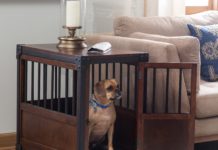
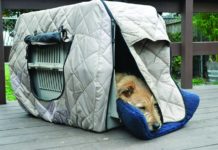

Yeah that’s true never live your I dog en the case for all dey..
Thanks for this helpful guide in crate training a puppy and how this will really help them become well behaved especially if we need to bring them to a friend or a family home. I would expect this could be a long process that needs time for the dog to learn. I might not be able to have the skills in doing this so I’ll just hire a trainer when I adopt a puppy.